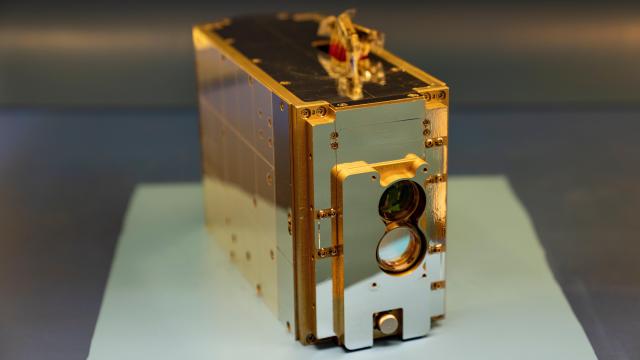A tiny gold-coated satellite lifted off from Earth on Wednesday with a rather large goal in mind for NASA: beam down data at the fastest rate ever achieved by space lasers.
The space agency’s TeraByte InfraRed Delivery (TBIRD) system launched aboard SpaceX’s Transporter-5 rideshare mission from Cape Canaveral Space Force Station in Florida. TBIRD is tasked with downlinking 200 gigabits of data per second, in what would be the highest optical rate achieved by a laser link from space, according to NASA.
NASA currently relies on a trusty old communications network that was built back in 1958 to communicate with its various spacecraft and other space-based assets. Called the Deep Space Network, it’s a global array of antennas that sends and receives radio-frequency transmissions. These transmissions travel between one of three ground-based communications facilities and the various target satellites, spacecraft, and space robots.
But as the space agency eyes further destinations like Mars and a long-duration return to the Moon, it seriously needs to work on its communication skills. Upgrading from radio frequency transmissions to laser communication would be akin to switching from dial-up to high-speed internet, according to NASA. “TBIRD is a game changer and will be very important for future human exploration and science missions,” Andreas Doulaveris, TBIRD’s mission systems engineer at NASA’s Goddard Space Flight Centre, said in a statement.
TBIRD is roughly the same size as a box of tissues, and it was integrated into a CubeSat — the Pathfinder Technology Demonstrator 3 — that’s no bigger than two cereal boxes stacked on top of each other. The device was developed by the Massachusetts Institute of Technology Lincoln Laboratory in Lexington and funded by NASA’s Space Communications and Navigation program. During an upcoming seven-minute test in low Earth orbit, TBIRD will attempt to downlink data to a NASA-run optical ground station; the test will require TBIRD to aim the laser precisely toward the ground-based receiver, located in Table Mountain, California.

Here’s how it works: Infrared lasers transmit data through optical terminals by encoding a message into an optical signal that is carried to a receiver. This method of transmitting data to and from space is considered to be faster and more secure. The brief test will provide NASA engineers with insights into the capabilities of laser communication. TBIRD is designed to operate for a period of six months in low Earth orbit, from where it will transmit its groundbreaking lasers.
“Small spacecraft continue to prove themselves vital building blocks for larger, more complicated missions,” Roger Hunter, program manager for Small Spacecraft Technology at NASA’s Ames Research Centre, said in a statement.
Space-based laser communication seems to be the way of the future. Earlier this month, two military satellites exchanged more than 200 gigabits of data across a distance of roughly 100 kilometres, in an achievement that could herald the construction of an entire satellite constellation.
